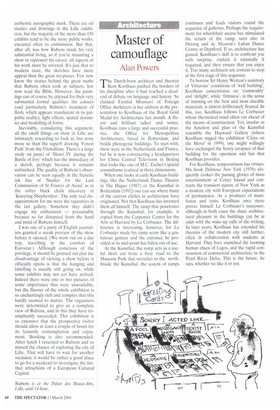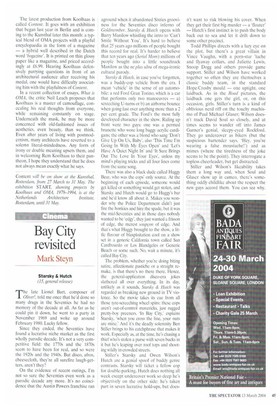Master of camouflage
Alan Powers
The Dutch-born architect and theorist Rem Koolhaas pushed the borders of his discipline after it had reached a deadend of debate on language and history. So claimed Farshid Moussavi of Foreign Office Architects in her address at the presentation to Koolhaas of the Royal Gold Medal for Architecture last month. A fluent and brilliant talker and writer, Koolhaas runs a large and successful practice, the Office for Metropolitan Architecture, based in Rotterdam, and builds photogenic buildings. To start with, these were in the Netherlands and France, but he is now constructing a headquarters for China Central Television in Beijing that looks like one of M.C. Escher's spatial conundrums realised in three dimensions.
When one looks at early Koolhaas buildings, like the Netherlands Dance Theatre in The Hague (1987) or the Kunsthal in Rotterdam (1992) one can see where many of the current cliches in architecture have originated. Not that Koolhaas has invented them all himself. The ramp that penetrates through the Kunsthal, for example, is copied from the Carpenter Center for the Arts at Harvard by Le Corbusier. The difference is interesting, however, for Le Corbusier made his ramp seem like a gratuitous gesture and the entrance he provided at its mid-point has fallen out of use.
At the Kunsthal, the ramp acts as a useful short cut from a busy road to the Museum Park that stretches to the north. Inside the Kunsthal, the system of ramps continues and leads visitors round the sequence of galleries. Perhaps the requirement for wheelchair access has stimulated the return of the ramp, seen also in Herzog and de Meuron's Laban Dance Centre at Deptford. If so, architecture has gained. Koolhaas's skill is to confront you with surprise, explain it rationally if required, and then ensure that you enjoy it. Too many architects are content to stop at the first stage of this sequence.
To borrow Sir Henry Wotton's summary of Vitruvius' conditions of 'well building', Koolhaas concentrates on 'commodity' and 'delight', while 'firmness', in the sense of insisting on the best and most durable materials, is almost deliberately flouted. In this, too, Koolhaas follows Le Corbusier whose theoretical mind often ran ahead of the means of construction. Yet, insofar as the function and plan of the Kunsthal resemble the Hayward Gallery (where Koolhaas staged the exhibition 'Cities on the Move' in 1999), one might willingly have exchanged the heavy carapace of that building for the openness and fun that Koolhaas provides.
For Koolhaas, temporariness has virtues. His book Delirious New York (1978) eloquently evokes the passing glories of mass entertainment at Coney Island and contrasts the transient nature of New York as a modern city with European expectations of permanence. As a producer of manifestos and texts, Koolhaas once more proves himself Le Corbusier's successor, although in both cases the sheer architectural pleasure in the buildings can be at odds with the wake-up calls of the writing. In later years, Koolhaas has extended his theories of the modern city still further, often in collaboration with students at Harvard. They have examined the teeming human chaos of Lagos, and the rapid construction of commercial architecture in the Pearl River Delta. This is the future, he says, whether we like it or not.
The latest production from Koolhaas is called Content. It goes with an exhibition that began last year in Berlin and is coming to the Kunsthal later this month: a typical blend of OMA projects with a playful encyclopaedia in the form of a magazine —a hybrid well described in the Dutch word `bogazine.. It is printed on thin glossy paper like a magazine, and priced accordingly at £6.99. Hearing Koolhaas defensively parrying questions in front of an architectural audience after receiving his medal, one would have difficulty associating him with the playfulness of Content.
In a recent collection of essays. What is OMA, the critic Neil Leach proposes that Koolhaas is a master of camouflage, concealing his real thoughts from everyone, while remaining constantly on stage. Underneath the mask, he may be more concerned with old-fashioned issues of aesthetics, even beauty, than we think. Even after years of living with postmodernism, many architects have reverted to a solemn literal-mindedness. Any form of irony or double meaning upsets them, and in welcoming Rem Koolhaas to their pantheon, I hope they understand that he does not always mean exactly what he says.
Content will be on show at the Kunsthal, Rotterdam, from 27 March to 31 May. The exhibition START, showing projects by Koolhaas and OMA, 1978-1994, is at the Netherlands Architecture Institute, Rotterdam. until 31 May.



































































 Previous page
Previous page